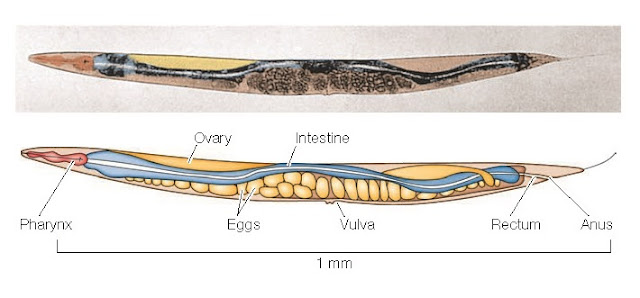CAENORHABDITIS ELEGANS AND DROSOPHILA MELANOGASTER
The unicellular yeasts are important models for studies of eukaryotic cells, but understanding the development of multicellular organisms requires the experimental analysis of plants and animals organisms that are more complex. The nematode Caenorhabditis elegans (Figure 1.17) possesses several notable features that make it one of the most widely used models for studies of animal development and cell differentiation.
 |
Figure
1.17 Caenorhabditis elegans The
nematode is widely used for studies of
animal development.
Although the genome of C. elegans (close to 100 million base pairs) is larger than those of unicellular eukaryotes, it is smaller and more manageable than the genomes of most animals. Despite its relatively small size, however, the genome of C. elegans contains approximately 19,000 genes more than three times the number of genes in yeast, and nearly the same number of protein-coding genes in humans. Biologically, C. elegans is a relatively simple multicellular organism: Adult worms consist of only 959 somatic cells, plus 1000–2000 germ cells. In addition, C. elegans can be easily grown and subjected to genetic manipulations in the laboratory.
The
simplicity of C. elegans has enabled the course of its development to be
studied in detail by microscopic observation. Such analyses have successfully
traced the embryonic origin and lineage of all the cells in the adult worm.
Genetic studies have also identified many of the mutations responsible for
developmental abnormalities, leading to the isolation and characterization of
critical genes that control nematode development and differentiation.
Importantly, similar genes have also been found to function in complex animals
(including humans), making C. elegans an important model for studies of
animal development.
Like
C. elegans, the fruit fly Drosophila melanogaster (Figure
1.18) has been a crucial model organism in developmental biology. The
genome of Drosophila is 180 million base pairs, larger than that of C.
elegans, but the Drosophila genome only contains about 14,000 genes.
Furthermore, Drosophila can be easily maintained and bred in the
laboratory, and its short reproductive cycle (about 2 weeks) makes it a very
useful organism for genetic experiments.
 |
Figure
1.18 Drosophila melanogaster The fruit fly is a
key model for genetics and developmental biology.
Many fundamental concepts of genetics such as the relationship between genes and chromosomes were derived from studies of Drosophila early in the twentieth century (see Chapter 4). Extensive genetic analysis of Drosophila has uncovered many genes that control development and differentiation, and current methods of molecular biology have allowed the functions of these genes to be analyzed in detail. Consequently, studies of Drosophila have led to striking advances in understanding the molecular mechanisms that govern animal development, particularly with respect to formation of the body plan of complex multicellular organisms. As with C. elegans, similar genes and mechanisms exist in vertebrates, validating the use of Drosophila as a major experimental model in contemporary developmental biology.




